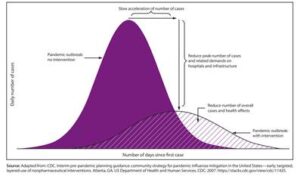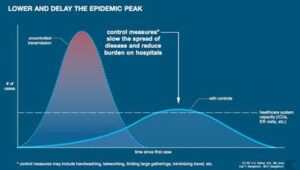SLC Health Director Guidance
As we learn more about COVID-19, I want to continue to provide information to the community on what we can do—community measures to slow the transmission and decrease the impact. We do not have the health system capacity for a significant outbreak. Please help us educate our communities on the importance of non-pharmaceutical interventions (NPIs).
Here I focus on Social Distancing: The St. Lawrence County Public Health Department recommends county residents use social distancing in all daily activities—stay home more often and keep your distance. Social distancing means staying away from crowds and others’ personal space to reduce the spread of the novel corona virus, or COVID-19. Social distancing measures can reduce the spread of the virus by decreasing the frequency and duration of social contact among persons of all ages. These measures limit face-to-face contact, which reduces person-to-person transmission. While St. Lawrence County currently continues with no confirmed cases of COVID-19, now is the time to proactively put in place strategies that will help control the spread of COVID-19.
Why should we employ social distancing and what does it mean? Our healthcare system does not have the capacity should we have a substantial outbreak of COVID-19. We need to move into action—now and fast. Community level NPIs are a first line of defense in the early stages of a pandemic. Without a vaccine, these strategies are what we have. We need to avoid public spaces as much as possible and limit moving about. We should all stay home more often and keep our distance from others. By implementing social distancing, we can:
- Delay the number of confirmed cases we see in St. Lawrence County.
- Reduce the peak number of cases in St. Lawrence County thereby reducing the demand and burden on our hospitals and healthcare system.
- Decrease the total number of overall cases and the health effects.
If you haven’t seen these 2 illustrations yet, please take a look…they clearly explain what implementation can do.


Additionally, this link to a Washington Post article helps visualize social distancing simulations and what can happen if implemented well: https://www.washingtonpost.com/graphics/2020/world/corona-simulator/
Social distancing measures can be implemented in a variety of community settings such as schools, workplaces, and public places where people gather (parks, religious institutions, theaters, and sports arenas). Recommended strategies include:
- Increase the distance between you and others to at least 6 feet.
- Limit face to face meetings and appointments: consider email, phone, and/or online encounters.
- Modify, postpone, or cancel activities and events: consider group size and target audiences. Reduce the number of people at each offering and think about high risk populations that may be present.
- Alter work environments and schedules: consider telework options, staggering schedules, arranging offices for increased spacing, limiting open hours, and offering open by appointment only options.
- Consider the overall necessity of going out: Do you need to? What essentials are needed? Can it wait?
In addition to these essential recommendations, personal and environmental NPI strategies remain just as important. Continue to use proper hand hygiene and cough etiquette, refrain from touching your eyes, nose, and mouth, self-monitor your own symptoms and stay home if you are sick, and clean and disinfect frequently touched surfaces.
The coming weeks will be challenging as regular routines will be disrupted. Implementing these strategies on a community-wide basis will be important in slowing down the person-to-person transmission, reducing the overall effects, and preventing the collapse of our healthcare system. I would like to thank you for your support as this health issue unfolds.
Dana Olzenak McGuire, PhD
St. Lawrence County Public Health Director




